Segment reports dynamically segment events on a route together into a single record set. The segment report returns separate records at any measure along the event where any of the attributes change. Segment reports can have multiple use cases depending on the needs of an organization and can provide the basis of analysis to evaluate legislation, policy, and budget options.
Learn more about segment reports

In this example, the process is for producing a segment report similar to the one shown previously.
Data required
The following data layers are used to create the report. The layer names used here are only examples. You can use your own layer names to produce your reports:
| LRS data type | Layer name | Explanation |
|---|---|---|
Network layer | MilePoint | The routes are selected from this layer. The layers are segmented on the selected routes. |
Event layer | AADT | The annual average daily traffic layer used to segment the routes. |
Event layer | IRI | The international roughness index layer used to segment the routes. |
Event layer | Surface type | The surface type layer used to segment the routes. |
Event layer | Urban_Type | The rural and urban type layer used to segment the routes. |
Selecting the network
The first step towards producing a segment report is to select the route network.
- Go to your reporting URL.
- Click the New Report button
 .
.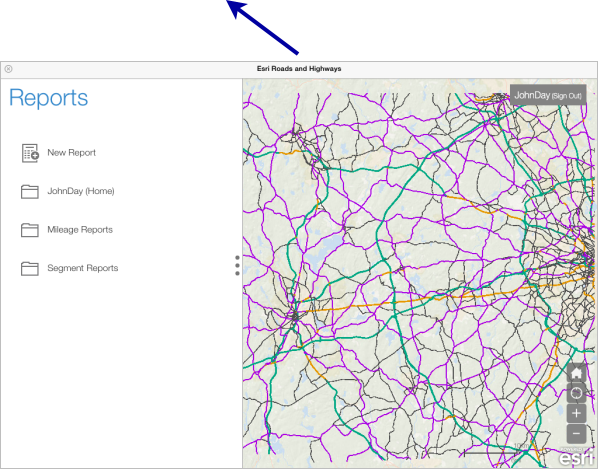
- Click the Segment Report button
 .
.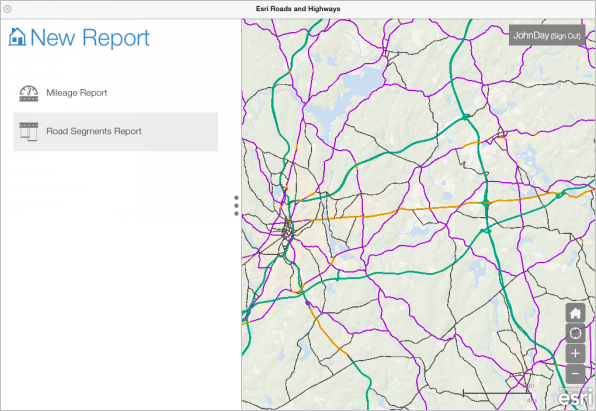
Create a new segment report - Choose the Route Network using the drop-down arrow.
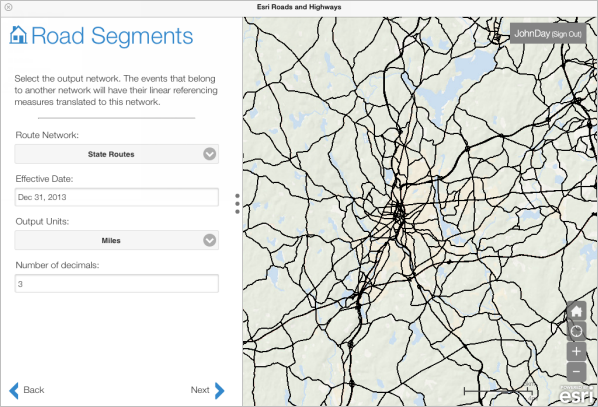
- Choose the Effective Date for the report.
- Choose the Output Units using the drop-down arrow.
The road segments will be reported using these units.
- Type the Number of decimals.
These are the number of decimals that show in the segments measures in the report.
- Click Next to select the routes.
Selecting the routes
The next step in the segment report creation process is to select the routes with which the segment measures will be calculated. There are two options available: spatial and attribute selection.
The spatial and attribute filters work in conjunction with each other. This means you can apply an attribute filter in addition to the spatial filter and vice versa. You can also choose to apply either of the spatial or attribute filters.
注:
If you want to select all the routes in your data to be used for reporting, do not apply any spatial or attribute filters.
提示:
You can use Show
SQL to write an SQL statement instead of using the selection method to create an attribute filter.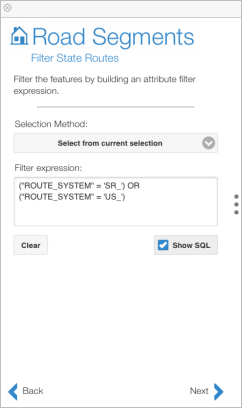
Spatial selection
You have several options for selecting the segments spatially: Drawing bounding graphics, Selecting polygon features, Select by proximity, Select by extent and Select by route.
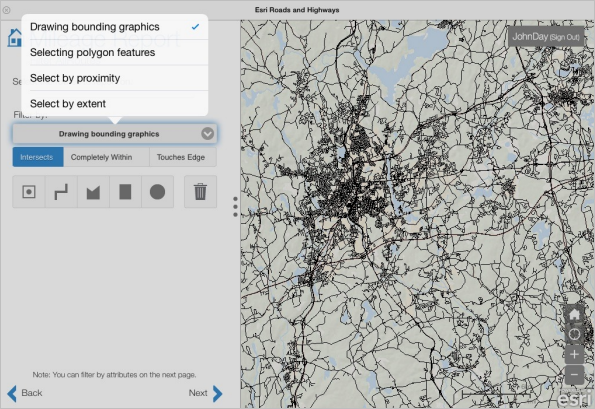
Drawing bounding graphics
Before you draw the bounding graphic or use any other spatial filtering tool, you have an option to apply the filter in three ways: Intersects, Completely Within, and Touches Edge.
 | Select By Point |
 | Select By Line |
 | Select By Polygon |
 | Select By Rectangle |
 | Select By Circle |
 | Clear Selection |
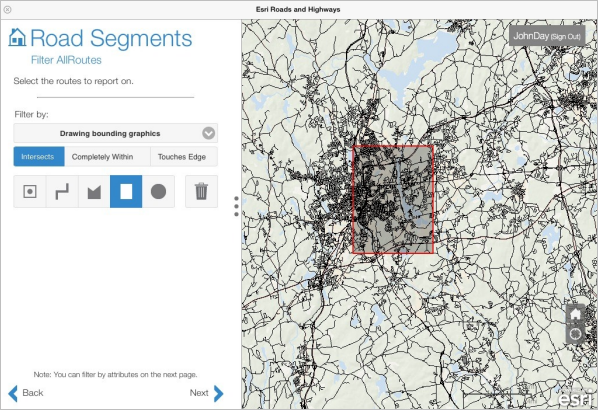
- Intersects—Routes that intersect the graphic get selected.
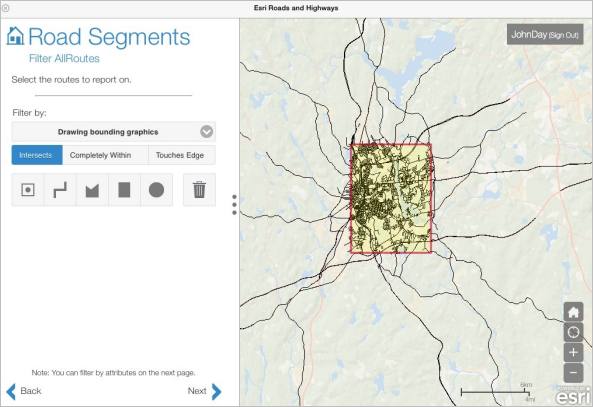
Routes that intersect the graphic - Completely Within—Routes completely within the graphic get selected.

Routes that are completely within the graphic - Touches Edge—Routes that touch the edge of the graphic get selected. A route that is within the graphic but not touching its edge will not be selected.
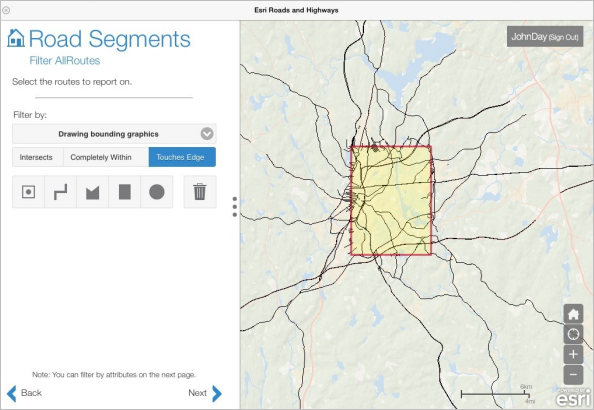
Routes that are touching the edge of the graphic
Selecting polygon features
You can use polygon features available in the map to select routes. For example, if you have administrative boundaries in the map, such as county or town boundaries, you can select the routes that intersect a particular county or town.
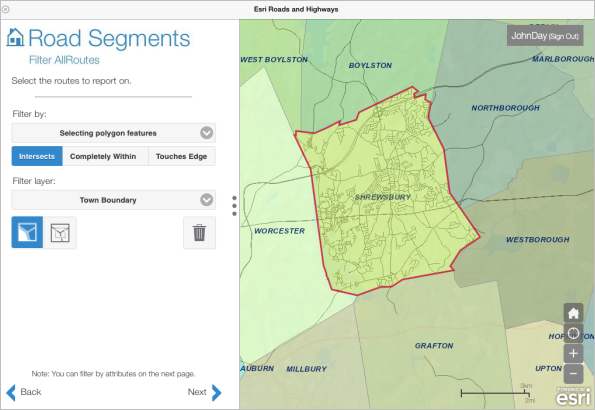
To use polygon features available in the map to select routes, complete the following steps.
- Choose Selecting polygon features from the Filter by list.
- Optionally choose a polygon layer from the Filter layer drop-down arrow.
注:
Filter layer is populated only if there are additional polygon layers in your map.
- Optionally filter proximity selection to routes that intersect, fall completely within, or touch the edge of the proximity border.
For example, in the screenshot below, those routes that fall completely within the polygons are selected.
- Click the Select by point button
 .
. - Click one or more polygons on the map.
You can also select routes that intersect multiple polygons.
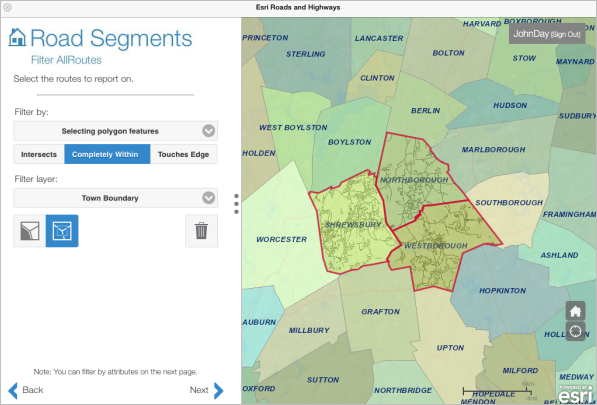
For selecting routes that intersect multiple polygons, complete the following steps.
- Click the Select by rectangle button
 .
. - Draw a box on the map that touches those polygons.
Select by proximity
You can select routes that are within a certain distance from a point located on the map.
- Choose Select by proximity from the Filter by list.
- Click the Select the center point button
 .
. - Click the Units drop-down arrow and choose the unit of measure.
- Type a distance for the unit of measure in the Distance text box.
- Optionally filter proximity selection to routes that intersect, fall completely within, or touch the edge of the proximity border.
For example, in the screenshot in step 6, those routes that fall completely within 12 miles are selected.
- Click the map to add a point.
The routes that fall completely within the resulting graphic will be selected.
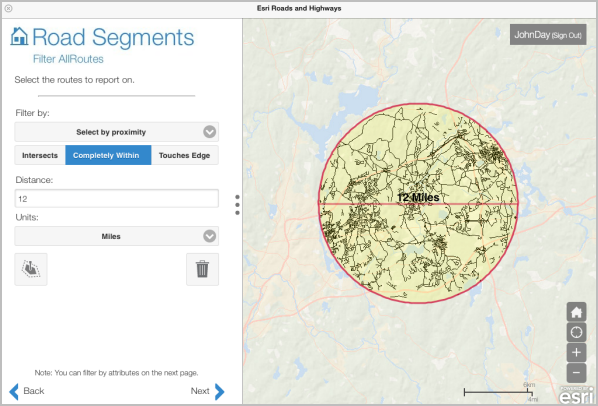
Selection by proximity
Select by extent
You can select routes that are within the present extent of the map.

- Choose Select by extent from the Filter by list.
- Click the Select current extent button
 .
. - Click Next to filter the features by attributes.
If you don't want to select the routes using attributes, then you can skip this step by clicking Next.
Select by route
You can filter routes by route ID either by selecting a route in the map or by typing the route ID.
- Choose Select by route from the Filter by list.
- Click the Select Route button
 to select a route on the map.
to select a route on the map. - Click a route on the map to select it.
提示:
You can also type the route ID into the Route ID text box.
- Click Next to filter the features by attributes.
Attribute selection
You can select the routes on the basis of attributes available in the network layer that you have selected to produce the report. There are three selection methods available (only when a spatial filter is applied):
Attribute selection options
| Selection method | Description |
|---|---|
Add to current selection | Applies an OR filter to the spatial selection |
Remove from current selection | Applies a NOT filter to the spatial selection |
Select from current selection | Applies an AND filter to the spatial selection |
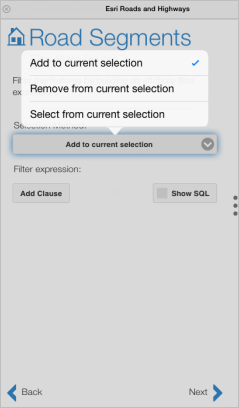
To add an attribute filter, complete the following steps:
- Choose a selection method.
In the example below, Select from current selection is chosen.

Attribute selection method chosen - Click Add Clause and select a field from the network layer on which the filter will be applied.
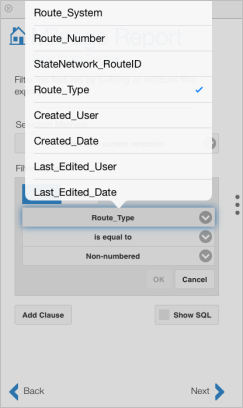
Selecting a field from the network layer - Choose the mathematical function and click the value.
- Click OK.
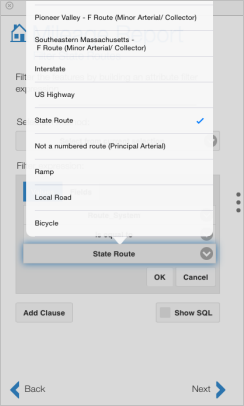
Selecting the field value 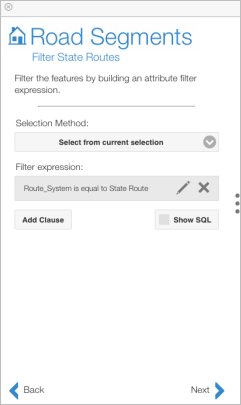
An attribute selection clause is added 提示:
You can add more attribute selection clauses by clicking Add Clause and choosing whether to apply an AND or OR logic to the first clause.
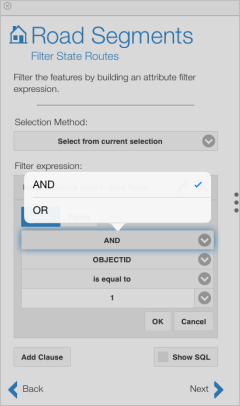
Adding a second attribute selection clause Follow the same procedure as described above to add a second clause.
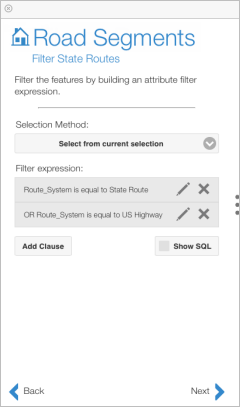
The second attribute selection clause is added - Click Next after applying the attribute filter.
Selecting the layers to segment
The next stage in creating a segment report is to select the layers to segment. You can optionally filter the features of each layer by building an attribute filter expression.
- Select one or more layers to segment.
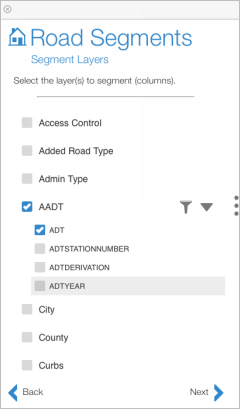
Selecting the layers to segment - If you want to add an attribute filter to the selected layer, select the Filter button
 to add an attribute selection clause.
to add an attribute selection clause.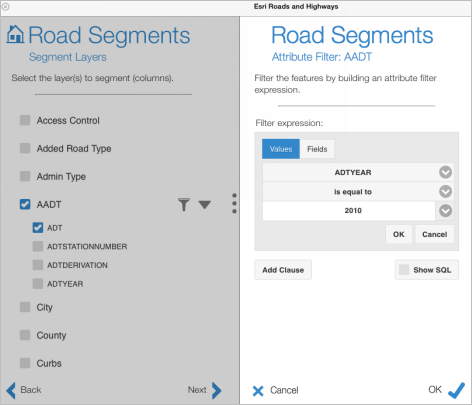
Adding an attribute filter Alternatively, you can filter the attributes of selected layers by unchecking them from the Segment Layers menu.
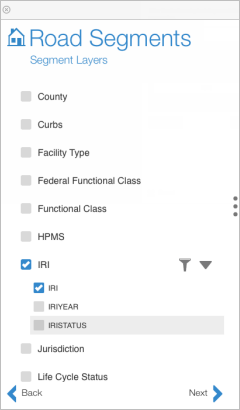
Filtering attributes for selected layers In this example, IRIYEAR and IRISTATUS attributes have been removed from the IRI layer. These attributes will not be included in the produced report.
- Click Next.